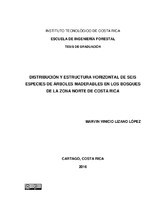Distribución y estructura horizontal de seis especies de árboles maderables en los bosques de la zona norte de Costa Rica
Abstract
It was collected information based on sampling of forest management plans, preliminary inventories and censuses, to know the optimal distribution and behavior of the horizontal structure with results of the abundance and absolute dominance of six species of timber trees in forests of the Northern Zone of Costa Rica. A total of 30 Forest Management Units (FMU) were chosen, they have an effective area of forest intervened ≥ 30 hectares, defined in a single fragment. Were divided into two sectors. It was considered data from 434 plots (0.15 and 0.3 ha) in the preliminary inventory (dbh ≥ 10 cm and 30 cm). Census data were obtained with dbh ≥ 60 cm; in a total effective area of 3284.8 ha. The results showed that the Dipteryx panamensis, specie with restricted timber in the country, it is abundant in the sampled areas in sector 2. Results obtained ˃ 1.78 individuals per hectare with dbh ≥ 10 cm. Comparisons of physical, biotic and structural variables between different FMU to define the optimal distribution, showed that species Tachigali costaricensis and Lecythis ampla, are more abundant at sites with higher temperatures, fewer days of rain and dry months (Sector 2). Sacoglottis thichogyna prefers sites with lower temperatures and rainy days (Sector 1). Dipteryx panamensis and Polychroma paraensis were distributed throughout the sampled area, without relating to environmental variables. In Hymenolobium mesoamericanum, it could not be associated its distribution, because of to its low values of abundance and frequency.
Description
Proyecto de Graduación (Licenciatura en Ingeniería Forestal) Instituto Tecnológico de Costa Rica. Escuela de Ingeniería Forestal, 2016.


